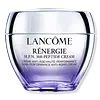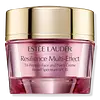Lancôme Rénergie H.P.N. 300-Peptide Cream Versus Estée Lauder Resilience Multi-Effect Tri-Peptide Face And Neck Creme SPF 15
What's inside
What's inside
 Key Ingredients
Key Ingredients

 Benefits
Benefits

 Concerns
Concerns

 Ingredients Side-by-side
Ingredients Side-by-side

Water
Skin ConditioningGlycerin
HumectantDimethicone
EmollientCetearyl Alcohol
EmollientTheobroma Grandiflorum Seed Butter
Skin ConditioningAlcohol Denat.
AntimicrobialCetearyl Isononanoate
EmollientNiacinamide
SmoothingGlyceryl Stearate
EmollientPEG-100 Stearate
Isopropyl Palmitate
EmollientOctyldodecanol
EmollientCyclodextrin
AbsorbentHydrolyzed Lupine Protein
Skin ConditioningPisum Sativum Extract
Skin ConditioningAdenosine
Skin ConditioningCapryloyl Salicylic Acid
ExfoliatingHydrolyzed Hyaluronic Acid
HumectantHydrolyzed Linseed Extract
Skin ConditioningPentaerythrityl Tetra-Di-T-Butyl Hydroxyhydrocinnamate
AntioxidantTrisodium Ethylenediamine Disuccinate
Tocopheryl Acetate
AntioxidantCera Alba
EmollientOrbignya Oleifera Seed Oil
EmollientSimmondsia Chinensis Butter
Skin ConditioningCetearyl Glucoside
EmulsifyingCitric Acid
BufferingHydroxyethyl Acrylate/Sodium Acryloyldimethyl Taurate Copolymer
Emulsion StabilisingPolysorbate 60
EmulsifyingPotassium Cetyl Phosphate
EmulsifyingSorbitan Isostearate
EmulsifyingTocopherol
AntioxidantDimethicone/Polyglycerin-3 Crosspolymer
CleansingBenzyl Alcohol
PerfumingGeraniol
PerfumingLimonene
PerfumingChlorphenesin
AntimicrobialDipropylene Glycol
HumectantPhenoxyethanol
PreservativeSodium Benzoate
MaskingParfum
MaskingWater, Glycerin, Dimethicone, Cetearyl Alcohol, Theobroma Grandiflorum Seed Butter, Alcohol Denat., Cetearyl Isononanoate, Niacinamide, Glyceryl Stearate, PEG-100 Stearate, Isopropyl Palmitate, Octyldodecanol, Cyclodextrin, Hydrolyzed Lupine Protein, Pisum Sativum Extract, Adenosine, Capryloyl Salicylic Acid, Hydrolyzed Hyaluronic Acid, Hydrolyzed Linseed Extract, Pentaerythrityl Tetra-Di-T-Butyl Hydroxyhydrocinnamate, Trisodium Ethylenediamine Disuccinate, Tocopheryl Acetate, Cera Alba, Orbignya Oleifera Seed Oil, Simmondsia Chinensis Butter, Cetearyl Glucoside, Citric Acid, Hydroxyethyl Acrylate/Sodium Acryloyldimethyl Taurate Copolymer, Polysorbate 60, Potassium Cetyl Phosphate, Sorbitan Isostearate, Tocopherol, Dimethicone/Polyglycerin-3 Crosspolymer, Benzyl Alcohol, Geraniol, Limonene, Chlorphenesin, Dipropylene Glycol, Phenoxyethanol, Sodium Benzoate, Parfum
Water
Skin ConditioningNeopentyl Glycol Diheptanoate
EmollientEthylhexyl Salicylate
UV AbsorberButyl Methoxydibenzoylmethane
UV AbsorberOctocrylene
UV AbsorberCetyl Alcohol
EmollientGlycerin
HumectantButyloctyl Salicylate
Skin ConditioningPentaerythrityl Tetraethylhexanoate
EmollientPolyethylene
AbrasiveDi-C12-15 Alkyl Fumarate
EmollientPetrolatum
EmollientHydrogenated Lecithin
EmulsifyingButylene Glycol
HumectantPropanediol
SolventHydrogenated Polyisobutene
EmollientOctyldodecyl Myristate
EmollientHexyldecyl Stearate
EmollientBehenyl Alcohol
EmollientCucumis Melo Fruit Extract
Skin ConditioningPolygonum Aviculare Extract
EmollientMyrtus Communis Leaf Extract
PerfumingLaminaria Digitata Extract
Skin ProtectingAcetyl Hexapeptide-8
HumectantTetradecyl Aminobutyroylvalylaminobutyric Urea Trifluoroacetate
Skin ConditioningLactoperoxidase
StabilisingGlucose Oxidase
StabilisingCholesterol
EmollientPropylene Glycol Dicaprylate
EmollientAminopropyl Ascorbyl Phosphate
AntioxidantSodium Hyaluronate
HumectantGlucose
HumectantAlgae Extract
EmollientArtemia Extract
Skin ConditioningAcetyl Glucosamine
Skin ConditioningSigesbeckia Orientalis Extract
Skin ConditioningGlyceryl Stearate
EmollientPersea Gratissima Oil
Skin ConditioningDimethicone
EmollientC12-16 Alcohols
EmollientTrehalose
HumectantEthylhexylglycerin
Skin ConditioningPEG-100 Stearate
Caffeine
Skin ConditioningPalmitic Acid
EmollientGlycine Soja Sterols
EmollientCaprylyl Glycol
EmollientIsohexadecane
EmollientPolymethyl Methacrylate
Trifluoroacetyl Tripeptide-2
Skin ConditioningTocopheryl Acetate
AntioxidantZinc PCA
HumectantPolysilicone-11
Polysorbate 80
EmulsifyingYeast Extract
Skin ConditioningPotato Starch Modified
Decarboxy Carnosine Hcl
Skin ConditioningXanthan Gum
EmulsifyingParfum
MaskingSodium Hydroxide
BufferingPotassium Sulfate
Acrylamide/Sodium Acryloyldimethyltaurate Copolymer
Emulsion StabilisingDextran
Hexylene Glycol
EmulsifyingDisodium EDTA
BHT
AntioxidantPotassium Sorbate
PreservativePhenoxyethanol
PreservativeCI 14700
Cosmetic ColorantMica
Cosmetic ColorantCI 77891
Cosmetic ColorantWater, Neopentyl Glycol Diheptanoate, Ethylhexyl Salicylate, Butyl Methoxydibenzoylmethane, Octocrylene, Cetyl Alcohol, Glycerin, Butyloctyl Salicylate, Pentaerythrityl Tetraethylhexanoate, Polyethylene, Di-C12-15 Alkyl Fumarate, Petrolatum, Hydrogenated Lecithin, Butylene Glycol, Propanediol, Hydrogenated Polyisobutene, Octyldodecyl Myristate, Hexyldecyl Stearate, Behenyl Alcohol, Cucumis Melo Fruit Extract, Polygonum Aviculare Extract, Myrtus Communis Leaf Extract, Laminaria Digitata Extract, Acetyl Hexapeptide-8, Tetradecyl Aminobutyroylvalylaminobutyric Urea Trifluoroacetate, Lactoperoxidase, Glucose Oxidase, Cholesterol, Propylene Glycol Dicaprylate, Aminopropyl Ascorbyl Phosphate, Sodium Hyaluronate, Glucose, Algae Extract, Artemia Extract, Acetyl Glucosamine, Sigesbeckia Orientalis Extract, Glyceryl Stearate, Persea Gratissima Oil, Dimethicone, C12-16 Alcohols, Trehalose, Ethylhexylglycerin, PEG-100 Stearate, Caffeine, Palmitic Acid, Glycine Soja Sterols, Caprylyl Glycol, Isohexadecane, Polymethyl Methacrylate, Trifluoroacetyl Tripeptide-2, Tocopheryl Acetate, Zinc PCA, Polysilicone-11, Polysorbate 80, Yeast Extract, Potato Starch Modified, Decarboxy Carnosine Hcl, Xanthan Gum, Parfum, Sodium Hydroxide, Potassium Sulfate, Acrylamide/Sodium Acryloyldimethyltaurate Copolymer, Dextran, Hexylene Glycol, Disodium EDTA, BHT, Potassium Sorbate, Phenoxyethanol, CI 14700, Mica, CI 77891
 Reviews
Reviews

Ingredients Explained
These ingredients are found in both products.
Ingredients higher up in an ingredient list are typically present in a larger amount.
Dimethicone is a type of synthetic silicone created from natural materials such as quartz.
What it does:
Dimethicone comes in different viscosities:
Depending on the viscosity, dimethicone has different properties.
Ingredients lists don't always show which type is used, so we recommend reaching out to the brand if you have questions about the viscosity.
This ingredient is unlikely to cause irritation because it does not get absorbed into skin. However, people with silicone allergies should be careful about using this ingredient.
Note: Dimethicone may contribute to pilling. This is because it is not oil or water soluble, so pilling may occur when layered with products. When mixed with heavy oils in a formula, the outcome is also quite greasy.
Learn more about DimethiconeGlycerin is already naturally found in your skin. It helps moisturize and protect your skin.
A study from 2016 found glycerin to be more effective as a humectant than AHAs and hyaluronic acid.
As a humectant, it helps the skin stay hydrated by pulling moisture to your skin. The low molecular weight of glycerin allows it to pull moisture into the deeper layers of your skin.
Hydrated skin improves your skin barrier; Your skin barrier helps protect against irritants and bacteria.
Glycerin has also been found to have antimicrobial and antiviral properties. Due to these properties, glycerin is often used in wound and burn treatments.
In cosmetics, glycerin is usually derived from plants such as soybean or palm. However, it can also be sourced from animals, such as tallow or animal fat.
This ingredient is organic, colorless, odorless, and non-toxic.
Glycerin is the name for this ingredient in American English. British English uses Glycerol/Glycerine.
Learn more about GlycerinGlyceryl Stearate is a mix of glycerin and stearic acid.
It is used to stabilize the mixing of water and oil ingredients. By preventing these ingredients from separating, it can help elongate shelf life. It can also help thicken the product's texture.
As an emollient, it helps soften skin and supports barrier-replenishing ingredients.
In cosmetics, Glyceryl Stearate is often made from vegetable oils or synthetically produced.
This ingredient may not be fungal-acne safe
Fun fact: The human body also creates Glyceryl Stearate naturally.
Learn more about Glyceryl StearateParfum is a catch-all term for an ingredient or more that is used to give a scent to products.
Also called "fragrance", this ingredient can be a blend of hundreds of chemicals or plant oils. This means every product with "fragrance" or "parfum" in the ingredients list is a different mixture.
For instance, Habanolide is a proprietary trade name for a specific aroma chemical. When used as a fragrance ingredient in cosmetics, most aroma chemicals fall under the broad labeling category of “FRAGRANCE” or “PARFUM” according to EU and US regulations.
The term 'parfum' or 'fragrance' is not regulated in many countries. In many cases, it is up to the brand to define this term.
For instance, many brands choose to label themselves as "fragrance-free" because they are not using synthetic fragrances. However, their products may still contain ingredients such as essential oils that are considered a fragrance by INCI standards.
One example is Calendula flower extract. Calendula is an essential oil that still imparts a scent or 'fragrance'.
Depending on the blend, the ingredients in the mixture can cause allergies and sensitivities on the skin. Some ingredients that are known EU allergens include linalool and citronellol.
Parfum can also be used to mask or cover an unpleasant scent.
The bottom line is: not all fragrances/parfum/ingredients are created equally. If you are worried about fragrances, we recommend taking a closer look at an ingredient. And of course, we always recommend speaking with a professional.
Learn more about ParfumPeg-100 Stearate is an emollient and emulsifier. As an emollient, it helps keep skin soft by trapping moisture in. On the other hand, emulsifiers help prevent oil and water from separating in a product.
PEGS are a hydrophilic polyether compound . There are 100 ethylene oxide monomers in Peg-100 Stearate. Peg-100 Stearate is polyethylene glycol ester of stearic acid.
Phenoxyethanol is a preservative that has germicide, antimicrobial, and aromatic properties. Studies show that phenoxyethanol can prevent microbial growth. By itself, it has a scent that is similar to that of a rose.
It's often used in formulations along with Caprylyl Glycol to preserve the shelf life of products.
Tocopheryl Acetate is AKA Vitamin E. It is an antioxidant and protects your skin from free radicals. Free radicals damage the skin by breaking down collagen.
One study found using Tocopheryl Acetate with Vitamin C decreased the number of sunburned cells.
Tocopheryl Acetate is commonly found in both skincare and dietary supplements.
Learn more about Tocopheryl AcetateWater. It's the most common cosmetic ingredient of all. You'll usually see it at the top of ingredient lists, meaning that it makes up the largest part of the product.
So why is it so popular? Water most often acts as a solvent - this means that it helps dissolve other ingredients into the formulation.
You'll also recognize water as that liquid we all need to stay alive. If you see this, drink a glass of water. Stay hydrated!
Learn more about Water